Michaels Mischief #3: Warming Island
Posted on 4 October 2011 by logicman
In Brief:
The melting of glacier ice in Northeast Greenland revealed in 2005 that land which - since 1822 - was thought to be a cape was in fact an island. It was named "Warming Island" because it had been uncovered due to local warming. The new island appears on many maps published since its discovery.
In 2008, Patrick Michaels claimed that a sketch map from a book of photographs showed that Warming Island was already a separate island in 1957. Shortly afterwards, Dennis Schmitt, the discover of Warming Island, wrote a strong rebuttal of Michaels' claim. In this SkS article, evidence not previously published on the web is presented to show that the 1957 map relied on by Michaels is not - and was never intended to be - accurate. If that sketch map accurately portrays the relevant coastlines (and hence sea level) as of 1957, then that sea level was at least 180 meters higher than it is today. Alternatively, the map is not accurate and Patrick Michaels' "theory" has no scientific basis.
At "skeptic" blog Watts Up With That (WUWT), David Middleton has resurrected Patrick Michaels' flawed article on Warming island. Here we will examine in detail the errors made by Michaels, and promoted by Middleton on WUWT.
According to David Middleton, "Pat Michaels debunked this particular Warmist myth back in 2008". In reality, it was Patrick Michaels' article which was debunked - by Dennis Schmitt, the discoverer of Warming Island. The rebuttal was given at the invitation of Andrew C. Revkin who posted it in this article. It is in the nature of some people to ignore rebuttals and just keep churning out the same old 'not happening' and 'natural cycles' climate change myths as if there had never been any scientific evidence against them. This creates a need for ever stronger rebuttals, which we seek to establish here.
The Discovery of Warming Island
In September 2005, explorer Dennis Schmitt discovered - in an area which he had personally explored by land 10 years earlier - that melting glacier ice had revealed a new strait. What had previously been assumed to be part of the mainland of Liverpool Land was now seen to be an island for the first time. Dennis Schmidt named this new island 'Uunartoq Qeqertoq', which is Inuit for 'The Warming Island'.
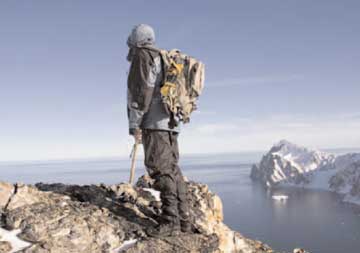
Dennis Schmitt standing on a peak on Warming Island (Source)
Satellite images from 1985, 2002 and 2005 show how the land ice has progressively retreated so as to leave a narrow strait of open water between Warming Island and Liverpool Land. These images constitute evidence in support of Dennis Schmitt's claim that he saw water in 2005 where he had seen ice in 1995.

Satellite images of Warming Island (Source)
I have annotated the image below, from the same source, to highlight the narrow strait and the two nearby islands which feature in rebuttals of Michaels' assertion.
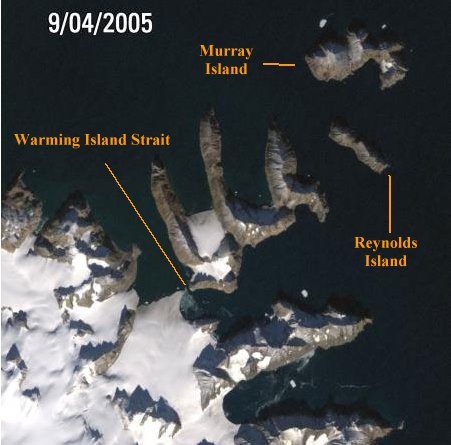
After its discovery, the new island was featured on many web sites, notably geotimes.org. The story was picked up by many newspapers, notably New York Times.
The 1957 Map
In 2008 Patrick Michaels published his article purporting to show that Warming Island had been seen from the air in 1957 and mapped by Ernst Hofer.
"Warming Island ... turns out to have been known to be an island back in the early 1950s"
Ernst Hofer is not widely known to either climate scientists or even Arctic historians, much less the general public. His book 'Arctic Riviera' is quite hard to find. Patrick Michaels has stated that his colleague Paul C. Knappenberger found an inconvenient book. According to Patrick Michaels, the sketch map in that 1957 book is accurate enough to clearly show Warming Island as an island prior to 1957. Michaels 'explains' that the island became separated in an earlier warm spell and refers his readers to a NASA GISS temperature graph as supporting evidence. Let us examine Michaels' evidence for validity and relevance.
The 1957 map and Liverpool Land detail (Annotations by Patrick Michaels)
The image above illustrates Patrick Michaels' evidence that Warming Island existed in 1957.
The next image from the same article shows the gist of Michaels' argument. He refers to the local glacier ice as an ice bridge. However, the term 'ice bridge' refers to sea ice, whereas the ice which has retreated is glacier ice. The difference in thickness and strength, and longevity in a warm environment is highly significant. Sea ice freezes in that area every year. Glacier ice could not have regrown to the 1985 extent from the extremely low 1957 extent which is required by Michaels' theory.
Arctic Fog
It is a notorious fact that fog is commonly encountered in the Arctic.
The 2008 rebuttal of Michaels' claims by Dennis Schmitt points to the absence of Reynolds Island from the 1957 map as very strong evidence of the map's inaccuracy. Schmitt suggests that the map is merely a sketch map which shows what would be seen from the air if the coast was shrouded in fog. Schmitt, a very experienced observer, supports his argument in some detail.
"The area’s maritime microclimate generates a prevailing fog belt that may cover up Reynolds Island (180 meters high) but will leave Murray Island (480 meters high) visible in rough outline. Warming Island with its high mountain walls invariably rises above the fog to show its rock outline while the connecting ice shelf along the entire oceanic straight is completely buried in fog. If I were to make a sketch of the region on such a typical summer day I would come up with pretty much the same blank spaces that I see in the Hofer document."
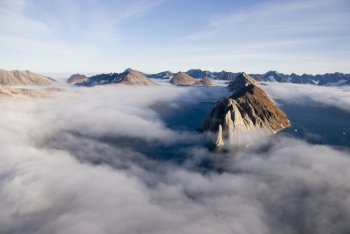
Warming Island in Fog. image copyright Jeff Shea (Source).
Despite Dennis Schmitt's very strong rebuttal, the matter has been raised again as if Michaels' claim had never been rebutted. This is what Ernst Hofer has to say about fog in Arctic Riviera:
" ... winter's severe reign is of long duration in the lands north of the Polar Circle; there is unrelieved darkness for long weeks on end, bitter cold and blizzards last for many months, and in summer dense fog often blankets the coastal regions."
"Deep depressions move along the east coast, and if easterly gales and storms set the drift-ice moving towards the fjords, there is rain and sleet, or wet snow, and many damp foggy days."
Ernst Hofer makes very many more references to the frequency of coastal fog. The idea that the map shows the Warming Island area in fog seems plausible.
In support of the 'coastal fog' rebuttal, here is a blink sketchmap which shows the area in question as it would look with and without a coastal fog bank, about 180 meters at its thickest, covering the northern tip of Liverpool Land.

This sketchmap is based on the contours shown on accurate maps. This image shows how fog could produce the outlines in the 1957 sketch map. Compare the width of the illusory strait here and the width of the real strait as shown in the satellite image, above. If the 1957 map is entirely accurate then the width of the strait as shown in that map was about 2.5 kilometers (km) and Reynolds Island was underwater (as it does not appear on the 1957 map). It follows that sea level when the map was drawn was some 180 meters - about 590 feet - higher than it is today, if Reynolds Island was below sea level in 1957. Alternatively, there was a major seismic event as Reynolds Island sank 180 meters and Warming Island shifted east by 2.5 km - an event which had reversed itself by 1985. There is no record - scientific or otherwise - of such globally significant events.
Remember that what Patrick Michaels has asserted about Warming Island is only a theory. His "theory" in a nutshell: the 1957 map of the East Greenland Coast is accurate, hence Warming Island was an island in 1957. This is an assertion unsupported by relevant and credible evidence and is in both the scientific and popular senses of the term just a theory.
The Irrelevance of Angmagssalik temperatures
In 1822, William Scoresby named Reynolds Island, Murray Island, and Cape Gladstone. The latter is now known as Warming Island. In his journal of 1823, Scoresby described how the flow of ice from the north was responsible for the prevalence of cold weather and fog along the coast which he had explored. It is now a notorious fact that the stream of polar ice affects the climate of the exposed coasts of East Greenland.
Michaels suggests that the local NASA GISS temperature record from the temperature station in Angmagssalik supports his contention that the 1957 map is accurate:
It does not. The GISS data, the only scientific evidence presented by Michaels, is from a weather station about 800 km distant from Warming Island, as shown in the image below, adapted from a graphic in Ernst Hofer's Arctic Riviera.

The two locations are about the same distance apart as Washington D.C. and Montreal. Angmagssalik and Warming Island have different climate regimes. Angmagssalik is south of the Arctic Circle, Warming Island is north of it and so is much colder, especially during winter. Angmagssalik weather station is in a fjord. Warming Island is on an exposed coast. The weather station at Angmagssalik is sheltered from the ice-stream which, as Scoresby noted, affects the local climate very strongly.
A Map Without Data
A graph or a map without data is just graphic art. It is incumbent on any person producing a map as proof of a geographical fact to show that the map is based on geographical data. Patrick Michaels asserts that the 1957 map, reproduced below, is accurate - but provides no data and no pointer to data.
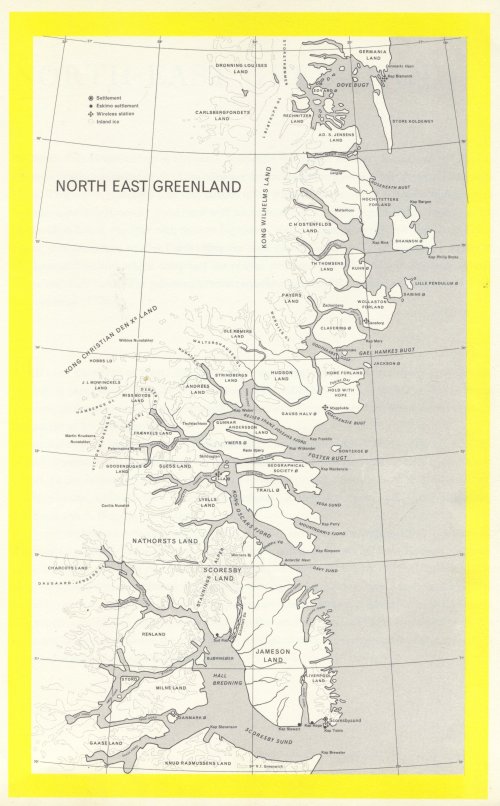
The map is not marked with a scale. It carries no cartographer's name, no initials, no brand, no mark of cartographic authenticity. Note the paucity of place names. There is a reason for this. The names relate to places personally visited by Ernst Hofer during his 'tour of duty' in Greenland - places which are mentioned or shown in his book of photographs. The book contains no description or photograph of the area around Warming Island. Warming Island lies at the northernmost tip of Liverpool Land. In the book, Ernst Hofer describes flying over a part of the coast of Liverpool Land. In fog.
Here is a detail of the above map, scanned at a much higher resolution, placed next to a small section of a 1984 geological map for ease of comparison. The dotted outline of the ice sheet in the 1957 map appears to be a fair approximation of the land ice. However, the outline of Warming Island is only a very rough approximation. Also, two islands are missing where I have placed the two green circles.
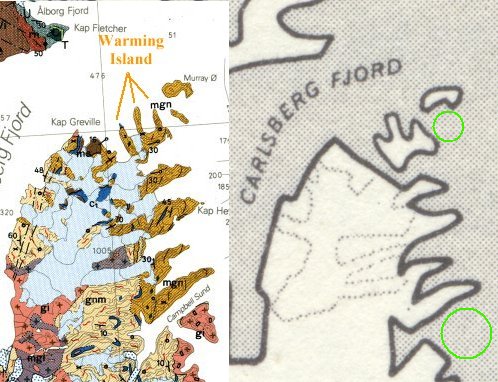
The ice joining Warming Island to Liverpool Land was clearly still present in 1984 when the very detailed geological map on the left was drawn. The map tallies perfectly with the 1985 satellite image, above. The 1957 sketch map, however, is obviously and seriously inaccurate. As the only known map of the region which seemingly shows Warming Island prior to 2005 it must be viewed with a great degree of skepticism.
It is quite clear that the map was never intended to be more than a guide to the areas which are described and illustrated in the book of photographs. No credit is given in the credits list for the map per se. That is to say, no cartographer is cited. The credits list does, however, give credit for the layout and graphic design. Ernst Hofer was not responsible for the map - his publisher was. Hofer describes in his book how he was employed by the justly famous Lauge Koch as a photographer. The book is basically a photo-album. On the final page, Ernst Hofer makes this abundantly clear when he gives some technical details of the photography -
"For the production of the illustrations to the picture-volume "Arctic Riviera" ..."
The region where Warming Island lies was exceedingly well explored and mapped by 1957. During the International Geophysical Year 1957-1958 the world's media was paying great attention to the polar ice, and to Greenland, as heroes from many nations battled extreme weather to expand our scientific knowledge. Had Ernst Hofer or his employer Lauge Koch discovered a newly detached island during the expedition he describes, it would have made the world's headlines. It didn't. Hofer never made such a claim. On the contrary:
"I do not claim, in the following pages, either to communicate specialised scientific knowledge or to give an account of sensational adventures and discoveries. I have merely tried to convey, simply and objectively, the impressions that the Arctic made upon a newcomer"
Summary
We are faced with a simple choice of scenarios: either the 1957 map is intended as a rough sketch map or it is an accurate sample of cartography.
- If the 1957 map is accurate, then the new strait was about 2.5 km wide in 1957. It is only about 0.25 km wide now.
- If the 1957 map is accurate, then Reynolds Island sank completely beneath the sea and then rose again.
Such substantial differences could only be due to cataclysmic variations in sea level and / or a major seismic event.
Since Patrick Michaels has presented no relevant evidence whatsoever in support of such an event, one is entitled to assume that the 1957 map is, accordingly, a sketch map flawed by insufficient data due to fog and as such is of no scientific value as evidence of geographical data. Despite this lack of evidence, Middleton recently claimed on WUWT:
"Uunartoq Qeqertaq is not a new island. Pat Michaels debunked this particular Warmist myth back in 2008…"
In reality it is Michaels' myth that has been debunked.
In the interest of balance and to ensure coverage of both sides of the climate debate, I respectfully suggest that David Middleton or Anthony Watts might want to advise their readers about Andrew Revkin's rebuttal - and perhaps this second rebuttal from SkS.
Of course, if supporters of the Warming Island 1957 "theory" insist they are right, and the glacier really did retreat from Cape Gladstone 50 years earlier than the scientific evidence asserts, then they must believe that global warming is proceeding at an extremely alarming rate.
I would like to conclude with some words of advice to David Middleton:
"Our advice—stick to the facts, let science tell its own story, and then let the people decide if and how they may want to respond. Of course, if everyone took our advice, we’d be out of material. So on second thought, keep the hype machine in full gear, we’re more than happy to spend our time exposing these, and other, silly global warming myths."
No, that quote is not from anyone here at SkS. It's from Patrick Michaels' own 2008 Warming Island article. It would appear that Michaels and Middleton are not heeding their own advice.
logicman (Patrick Lockerby)
------------------------------
Fair use is claimed for copyright materials used in this article on the grounds that such use is intended to promote the good reputations of the originators.































 Arguments
Arguments






























[DB] Fixed image.
[DB] Enabled in-line graphic.
I would certainly entertain that as a possibility, but if your argument depends on the difference between the Warming Island climate and that at Tasiilaq/Angmagssalik, then there was no excuse for not showing the more local and relevant temperature series from Danmarkshavn.
[PS] I sincerely hope your link to "clash of clans" stuff was error not spam. I deleted the link but feel free to post what you meant.